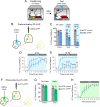Divergent projections of the prelimbic cortex bidirectionally regulate active avoidance
- PMID: 33054975
- PMCID: PMC7588229
- DOI: 10.7554/eLife.59281
Divergent projections of the prelimbic cortex bidirectionally regulate active avoidance
Abstract
The prefrontal cortex (PFC) integrates incoming information to guide our actions. When motivation for food-seeking competes with avoidance of danger, the PFC likely plays a role in selecting the optimal choice. In platform-mediated active avoidance, rats avoid a tone-signaled footshock by stepping onto a nearby platform, delaying access to sucrose pellets. This avoidance requires prelimbic (PL) PFC, basolateral amygdala (BLA), and ventral striatum (VS). We previously showed that inhibitory tone responses of PL neurons correlate with avoidability of shock (Diehl et al., 2018). Here, we optogenetically modulated PL terminals in VS and BLA to identify PL outputs regulating avoidance. Photoactivating PL-VS projections reduced avoidance, whereas photoactivating PL-BLA projections increased avoidance. Moreover, photosilencing PL-BLA or BLA-VS projections reduced avoidance, suggesting that VS receives opposing inputs from PL and BLA. Bidirectional modulation of avoidance by PL projections to VS and BLA enables the animal to make appropriate decisions when faced with competing drives.
Keywords: Archaerhodopsin; amygdala; channelrhodopsin; fear; neuroscience; optogenetics; rat; striatum.
© 2020, Diehl et al.
Conflict of interest statement
MD, JI, JM, GR, FG, VV, GQ No competing interests declared
Figures








References
Publication types
MeSH terms
Grants and funding
LinkOut - more resources
Full Text Sources
Miscellaneous

